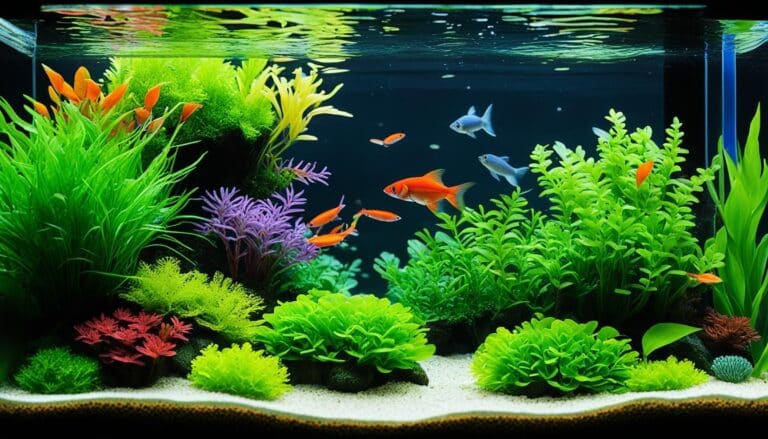Aquarium plants are more than just a nice touch—they play a huge role in keeping your water garden healthy. Floating plants, in particular, are awesome because they add oxygen to the water, give fish some extra hiding spots, and help keep the water clean and clear. They’re like a natural filter that benefits both fish and plants.
In this guide, I’ll walk you through how to choose and care for beginner-friendly, low-maintenance floating plants. The goal here is to make it easy for anyone, whether you’re setting up your first tank or just looking for simple plants to take care of. With the right tips and tricks, you’ll be able to create a beautiful and healthy aquatic environment without much fuss.
Let’s dive in and make your aquarium setup both fun and successful!
Benefits of Having Floating Aquarium Plants

As an aquarium enthusiast, I’ve come to appreciate how floating plants do way more than just make a tank look nice—they’re game-changers when it comes to keeping the ecosystem balanced and ensuring my aquatic pets are healthy. Let’s dive into why these plants are such a great addition.
Floating plants can cover 40-60% of the water’s surface, creating that perfect bit of shade while regulating the light levels in your tank. This helps prevent algae from taking over by blocking excess light. Plus, it gives my fish, shrimp, and snails a cozy, natural environment where they can feel at home, just like in the wild.
If you’re looking for easy-care plants, Amazon Frogbit and Water Lettuce are perfect. They thrive with medium light and are super low-maintenance, so they’re great if you want to enjoy your tank without much hassle. Duckweed is another fantastic option—it grows quickly, provides great cover for smaller critters, and helps clean the water by absorbing extra nutrients like nitrates.
One of the best things about floating plants is how they keep the water clean by naturally filtering out pollutants. It’s amazing to see how they control levels of ammonium and nitrates, which keeps my fish healthy and vibrant. They also help maintain good oxygen levels in the water, which is vital for fish, especially when aiming for that sweet spot of 4-6 mg/L of dissolved oxygen.
Here’s a fun fact—some floating plants, like Duckweed, are high in protein, containing about 37% crude protein. This makes them a budget-friendly food source for fish, offering nutrition while they naturally graze.
Of course, these plants can grow fast and sometimes overshadow other plants in the tank. But by choosing the right species and maybe setting up some barriers, you can easily manage their growth, letting them add beauty without taking over the whole space.
Since adding floating plants to my aquarium, I’ve seen a real improvement—not just in how it looks but in the overall water quality and the health of everything living in it. The benefits are endless, making floating plants a must-have for any thriving aquarium!
1. Duckweed
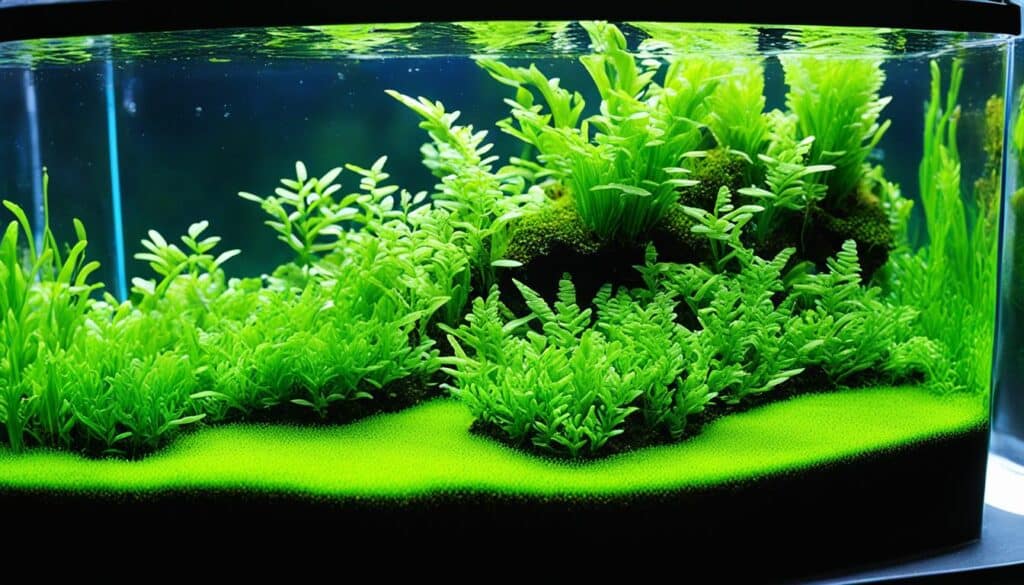
Duckweed, also known as Lemna minor, is a go-to choice for easy aquarium plants. Despite its tiny size, it provides excellent surface coverage and quickly makes any tank look more natural. Its rapid growth and low-maintenance care make it perfect for both beginners and seasoned aquarists.
To keep duckweed thriving, you just need to create the right environment. It prefers moderate lighting—not too bright, but not too dim. While it doesn’t require CO2, adding a little liquid fertilizer can boost its growth and keep it looking vibrant.
One of the best things about duckweed is how quickly it spreads, which brings a ton of benefits. It helps clean the water by absorbing excess nutrients, which also helps keep pesky algae at bay. Plus, the dense layers it forms are perfect for fish and shrimp to hide and nest in, making your tank a more dynamic environment.
However, keeping an eye on your duckweed is important because it can grow out of control if left unchecked. Regularly removing some of it will help maintain a balanced look and keep your tank from getting too crowded.
Beyond aquariums, duckweed has other interesting uses—it’s actually a nutritious feed for farm animals, showing just how versatile and valuable this little plant is.
In the end, duckweed’s simple care requirements, great surface coverage, and natural water-cleaning abilities make Lemna minor a top favorite. It’s a fantastic addition to any aquarium, offering an easy way to keep your water garden looking healthy and beautiful.
2. Amazon Frogbit

I love making my aquarium setups both useful and beautiful. So, Amazon Frogbit care is a must for me. This floating plant, Limnobium laevigatum, spreads fast and is easy to keep. It’s perfect for anyone wanting to make their aesthetic aquarium look better.
For beginners, taking care of floating plants might seem tough. But the Amazon Frogbit is easy to handle. It needs medium light for 8 to 12 hours daily. This makes a lovely green cover on the water’s surface. This not only looks great but helps the fish below by providing shade and safety.
If you’re thinking of adding Amazon Frogbit to your water garden, here’s what you need to know:
Product Details |
Shipping & Handling |
|---|---|
Combo package includes 6 Mini Amazon Frogbit plants and 6 Water spangles |
Ships within 1-3 business days |
Price: Originally $18.99, now $15.99 |
USPS First Class or Priority Mail (2-5 business days) |
Currently out of stock |
Free US Standard Shipping on orders over $35 |
One year manufacturer warranty for Aquarium LEDs |
No international shipping for plant products |
Non-plant orders can be returned within 30 days, 15% restocking fee may apply |
Product modification or tampering by unauthorized parties voids warranty |
In summary, the Amazon Frogbit is an excellent pick for both new and experienced fish tank lovers. It makes the tank more beautiful and helps keep the fish healthy and safe.
3. Java Moss
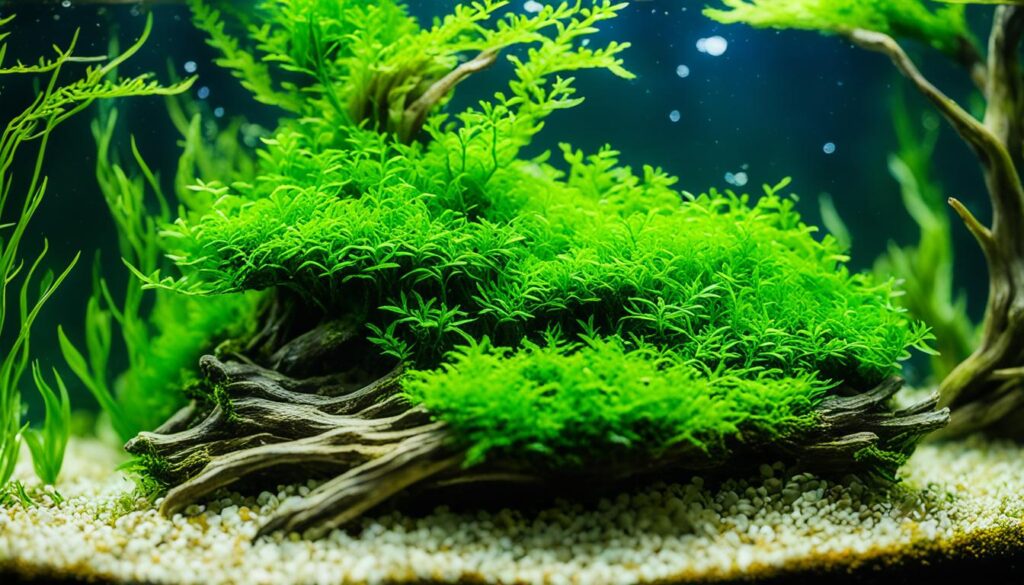
Java Moss, known as Vesicularia dubyana, is a top pick for aquarium lovers. It’s easy to care for because it does well in different water conditions and light. This makes it perfect for beginners.
It can float freely or attach to rocks and wood. This way, it creates beautiful green scenes in your aquarium. Java Moss is also great for small creatures like invertebrates. It gives them a safe place to hide and find food.
When you decide to add Java Moss, make sure it’s healthy and free from pests. Here are things to watch for:
Condition |
Details |
|---|---|
Live Arrival |
Gurantee valid for 24 hours post-delivery; requires photo evidence of any issues upon arrival. |
Guarantee Void |
Conditions such as ‘invalid address’ or ‘undeliverable’ status. |
Pest-Free Promise |
Tissue culture plants are guaranteed pest-free but always recommended to rinse and quarantine Java Moss before introduction to your tank. |
By knowing these conditions, you can help your Java Moss thrive in your tank. Your setup plays a big role in its success.
Many aquarium fans say Java Moss is easy and pretty. It’s great for anyone starting an aquatic garden, especially with shrimp or small water creatures.
4. Hornwort
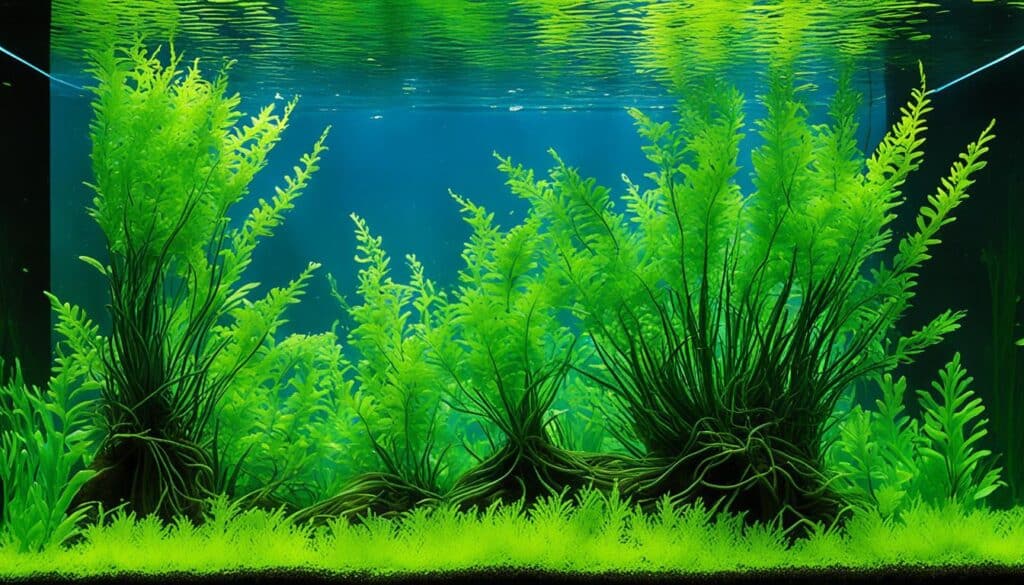
I love home aquariums and find Hornwort benefits amazing. It’s known as Ceratophyllum demersum in the science world. This plant grows fast and can adapt to many environments. It’s great for controlling algae and protecting baby fish.
Hornwort does well in temperatures from 50-85°F (10-30°C). It fits into tropical aquariums, coldwater tanks, and outdoor ponds. It survives nearly everywhere, except Antarctica. This shows how adaptable it is.
The plant grows 1-4 inches each week in the right conditions. It makes the aquarium lively for fish and tiny creatures. But, if the water changes a lot or there’s not enough light, it might lose needles.
Here are some tips on propagation and taking care of Hornwort:
Characteristic |
Detail |
|---|---|
Propagation |
Easily done by cutting a side shoot or trimming the top of a stem. |
Care Level |
Low; tolerates a wide range of conditions. |
Temperature Tolerance |
50-85°F (10-30°C); suitable for various aquarium setups. |
Shedding |
Occurs under stress or unfavorable conditions. |
Environmental Benefit |
Acts as natural algae control, absorbing excess nutrients. |
Biological Benefit |
Provides shelter and habitat for fish fry and small invertebrates. |
Adding Hornwort to your aquarium makes it look better and healthier for the fish. It helps control algae and gives a safe place for baby fish. Try it out and see the benefits for yourself!
5. Water Sprite
![]()
For those starting with beginner aquariums, Water Sprite (Ceratopteris thalictroides) is a great plant choice. It’s easy to care for and can grow in different ways. Whether underwater or floating on top, it adjusts well. Let’s look into how to grow Water Sprite and its benefits.
Water Sprite can grow by rooting in the ground or floating. This makes it great for fish babies to hide and helps keep the water clean. Below, you’ll find a table with more info on growing this plant right:
Characteristic |
Details |
|---|---|
Common Names |
Water Fern, Indian Fern, Indian Water Fern |
Light Requirement |
Low to Moderate |
Growth Rate |
Moderate |
Propagation |
Stem Cuttings, Mother Plant Trimmings |
CO2 Requirement |
Not required |
Maximum Size |
Up to 12 inches or more |
Preferred Fertilizers |
Root Tabs, Liquid Fertilizers |
When I first got into beginner aquariums, Water Sprite quickly showed why it’s loved. People often talk about Water Sprite cultivation on my blog. For instance, “Wasserpest” saw their plant grow half an inch in just one day!
This plant does well in many conditions, according to both my experience and others’. It’s perfect for anyone looking to make their aquariums livelier and more natural.
6. Water Wisteria
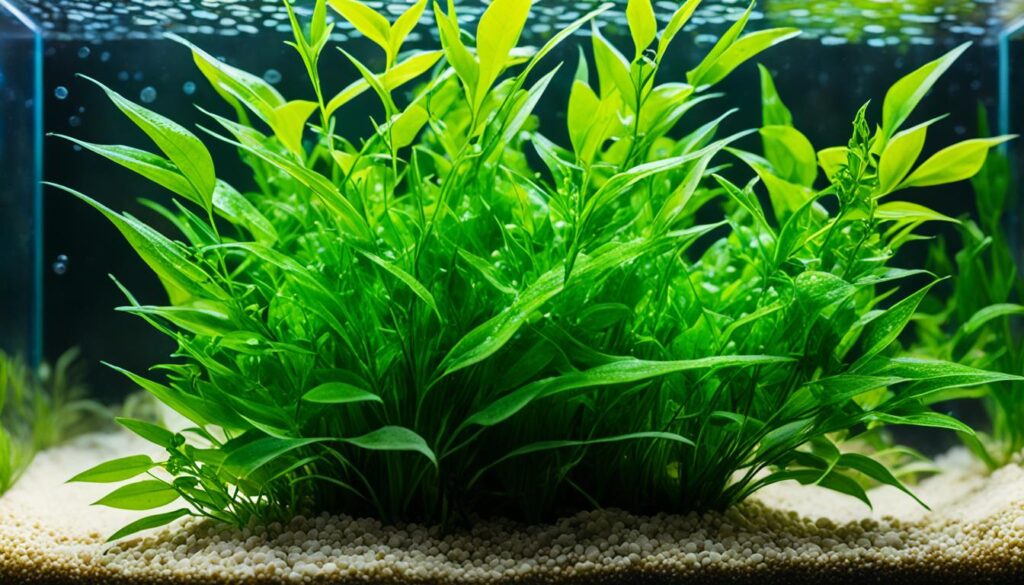
Water Wisteria, known scientifically as Hygrophila difformis, thrives in my aquarium. It shows the beauty of easy-grow aquatic plants. Famous for its adaptability and quick growth, Water Wisteria care is simple. This makes it great for beginners and experts alike.
It’s native to the Indian subcontinent. Hygrophila difformis grows well either in the ground or floating. Floating, its leaves turn lace-like which looks nice. It’s one of the low maintenance plants and adjusts to various water conditions. Hence, many aquarium lovers favor it.
Feature |
Detail |
|---|---|
Live Arrival Guarantee |
Guaranteed alive on arrival if notified within 24 hours of delivery; conditions apply. |
Plant Health |
Free of pests and algae if in tissue culture; rinsing advised before use. |
Usage Tips |
Can be left floating until it develops roots; ideal for pearling after root establishment. |
Community Feedback |
Highly praised for its rapid, robust growth and versatility in tank placement. |
To make Water Wisteria grow well, check the water and light regularly. Water Wisteria care doesn’t mean no pests, so start with a quarantine. This keeps your tank healthy.
Adding Hygrophila difformis to your collection makes your aquarium look great. It’s a strong and low maintenance plant choice. It’s easy for beginners and interesting for experienced aquarists. If you want an easy-to-care-for plant underwater, choose Water Wisteria.
7. Pennywort
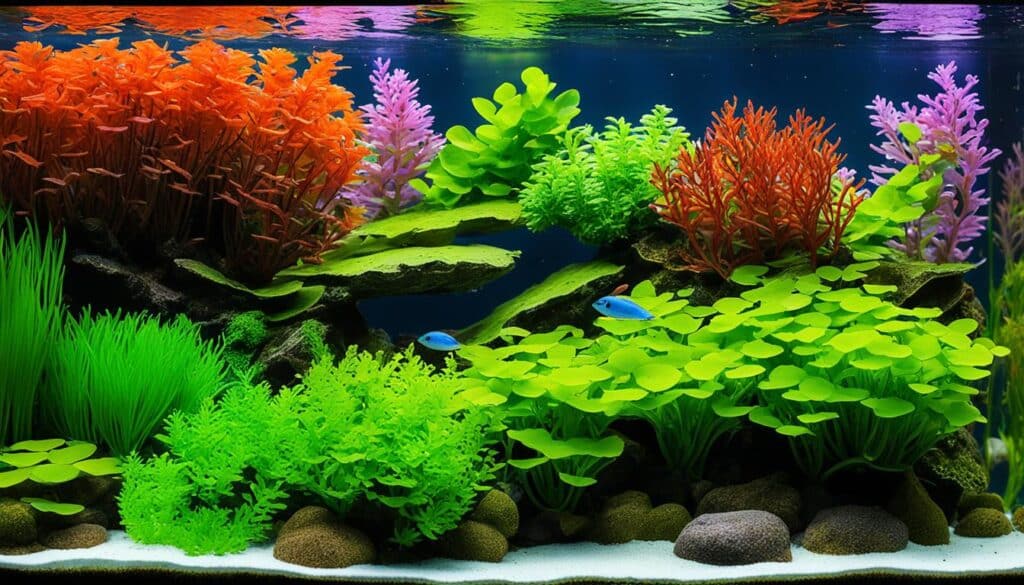
Pennywort, or Hydrocotyle spp., is a top choice among floating aquarium plants. It’s known for its unique coin-shaped leaves and bright green color. Pennywort not only makes your aquarium look good but also improves the water by cycling nutrients.
Many keepers love Pennywort because you can put it anywhere in the tank and it grows quickly. You can let it float on the water or plant it in the ground. This plant is good at taking up nutrients, which keeps the water clean and clear. Taking care of Pennywort is a task that pays off.
Aquarists talk about their methods for growing Pennywort well in forums. They often use suction cups or tie stems together for bushier growth. Many also use Pennywort to hide equipment or provide shade. These ideas are popular in forum threads, some with over 16K views.
Parameter |
Details |
|---|---|
Forum Engagement |
16,000 views on topic, 9 replies related specifically to Pennywort use |
Growth Observations |
Horizontal spread along surface, vertical growth after reaching length |
Maintenance Frequency |
Trimming advised every few weeks due to rapid growth rate |
Installation Techniques |
Uses of suction clips, attaching to tank sides, outflow affixation |
These fascinating forum discussions show how much aquarists value Pennywort. It is loved for both its looks and its role in keeping the tank healthy. Whether it’s anchored or floating, Hydrocotyle spp. stands out for its ability to adapt and thrive.
8. Water Lettuce

Water Lettuce, also known as Pistia stratiotes, is a top choice among plants for home aquariums and outdoor ponds. Not only does it look lush and vibrant floating on the water, but it also benefits the water’s health and balance. With a quick growth rate, Water Lettuce provides essential shade for fish and helps reduce algae.
This plant has spongy, ribbed leaves that look like a floating lettuce head. It’s perfect for anyone interested in adding floating plants to their aquarium. Beginners and experts alike find it great for improving water quality and creating hiding spots for aquatic life.
Thriving in calm or slow-moving water, Pistia stratiotes is easy to take care of. It’s especially good for beginners. Just be sure to control its growth in outdoor areas to avoid harming local waters.
Here’s what you need to know about getting this plant:
Statistic |
Detail |
|---|---|
Available Quantity |
5 plants |
Price |
Approximately US $7.61 |
Number of Units Sold |
362 |
Location |
Stoke-on-Trent, United Kingdom |
Returns Policy |
30 days, buyer pays return shipping |
Exclusion from Shipping |
Afghanistan, Libya, Nauru, Russian Federation, Somalia, Ukraine, Yemen |
Water Lettuce is easy to care for and provides big ecological perks. It’s a must-have for aquarists who want to beautify and balance their tanks. Adding it can upgrade both new setups and existing aquariums with its benefits and beauty.
9. Cabomba Caroliniana
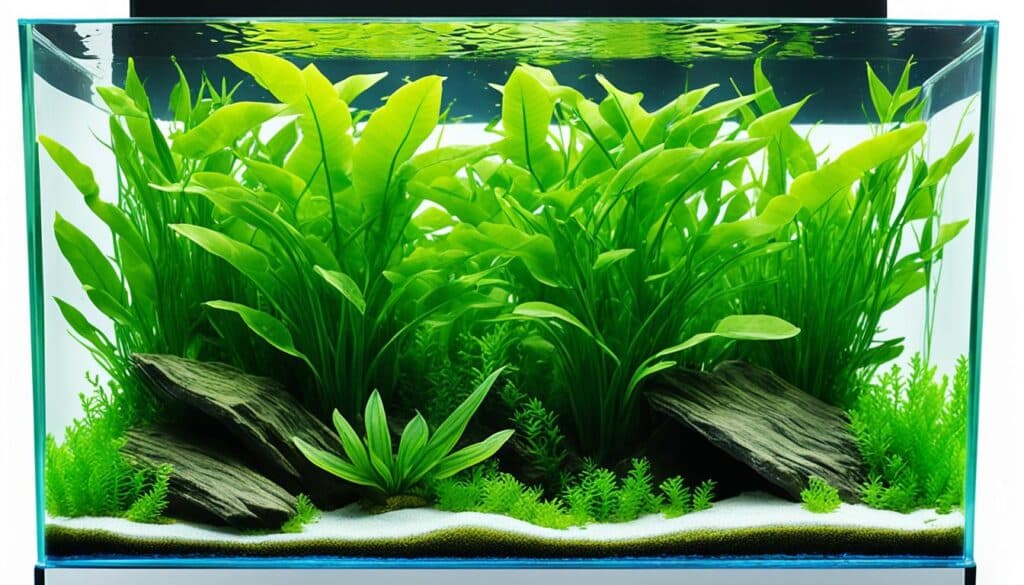
Cabomba Caroliniana, often called fanwort, is great for making your aquarium look better. It is beautiful and gives fish a place to live. Its feathery leaves improve water quality and make your tank look lush.
Cabomba care needs moderate light and clean water with nutrients. Though fanwort needs a bit more work, it’s worth it for its beauty and benefits. It also adds oxygen to the water, helping your aquarium stay healthy.
Fanwort looks best in the middle or back of your tank. It makes the aquarium look full and green, just like fanwort’s natural home. This helps it grow strong and look bright.
Adding aquarium planting like Cabomba Caroliniana is key to a good tank setup.
It makes your aquarium look nicer and keeps the water healthy. Here’s a quick look at what it offers:
Characteristic |
Importance |
|---|---|
Lush Greenery |
Makes the aquarium look pretty and gives fish places to hide |
Oxygenation |
Makes the water better by adding more oxygen |
Ecosystem Balance |
Keeps water healthy, making life easier for all the fish |
Thinking of adding more plants to your tank? Fanwort is a great choice. It can turn a simple tank into a beautiful underwater garden. Good Cabomba care makes all the difference.
Practical Care Tips for Floating Aquarium Plants
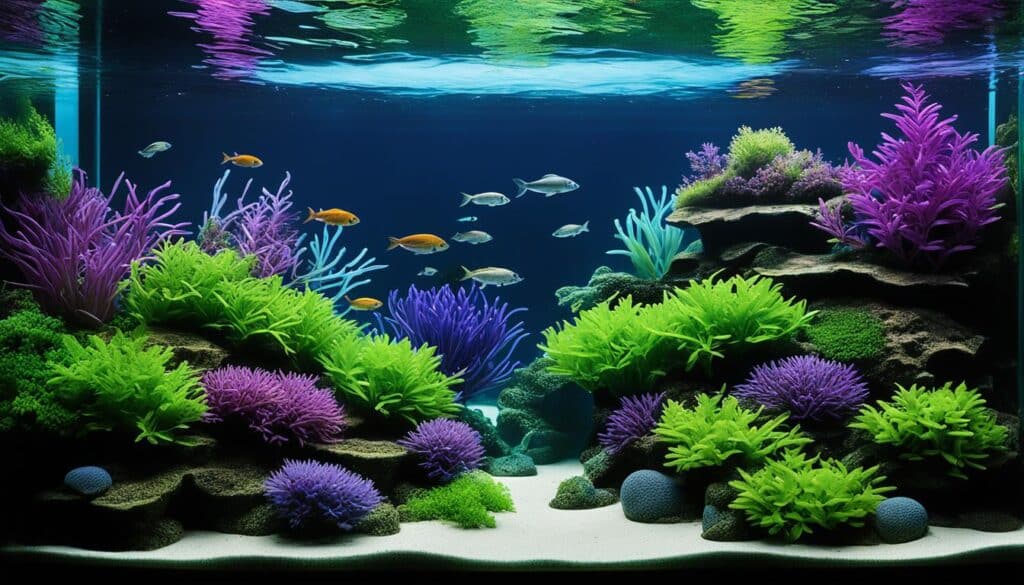
Keeping your aquarium vibrant and healthy is not hard if you know what to do, especially with floating plant maintenance. These floating plants make your tank look better and help improve the water’s ecosystem.
Checking your floating plants often is key. This helps spot any health issues early, like diseases or missing nutrients. For example, if your plants are the wrong color or not growing right, they might need more nutrients or better water.
Here are some simple tips to take good care of your floating plants:
- Consistent Water Quality: It’s important to check your aquarium’s water for nitrates, nitrites, pH, KH, and GH regularly. Keeping these levels right means your fish and plants stay healthy.
- Lighting: Floating plants need about 8-10 hours of light each day. But too much light can make algae grow. So, it’s best to find a good balance.
- Nutrient Supply: Using liquid fertilizers gives your plants important nutrients they might not get otherwise.
- Pruning: Trimming your plants now and then keeps them from spreading too much and making the tank too shaded.
Doing the right aquarium care techniques will help your floating plants and your whole tank:
Action |
Benefit |
|---|---|
Adding liquid fertilizer |
Makes plants healthier and look better. |
Maintaining appropriate water temperature (74-80°F) |
Keeps plants and fish healthy, avoiding sickness. |
Pruning plants regularly |
Limits how big plants get, ensuring light and space for all in the tank. |
Testing water weekly |
Helps maintain the right water conditions, avoiding problems. |
For a successful aquarium aquascaping and floating plant maintenance, be consistent. Regular care boosts plant health and helps your aquatic environment balance. Adjust these tips to fit your tank’s needs to keep your floating plants looking great.
A Balanced Aquarium with Floating Plants
Creating a thriving aquarium ecosystem is both rewarding and complex. It requires a deep understanding of balance and the roles of floating plants. We’ve looked at ornamental water plants, and it’s clear they’re more than just pretty. They bring life to the aquarium. Plants like Water Lettuce and Amazon Frogbit shade the water and clean it. This shows how floating plant advantages are many.
My aquarium design journey has taught me to blend beauty with function. Salvinia and Red Root Floaters are beautiful and also help with oxygenation. They provide safe places for young fish to hide. These plants suggest we might not always need mechanical filters.
A balanced aquarium cuts down on algae, keeps water clean, and makes a peaceful home for fish. Reflecting on intentional design, I see how small ecosystems can thrive. The beauty of Duckweed and the shade from Water Lettuce show harmony is key. With the right floating plants, any aquarium can not only survive but also thrive beautifully.
